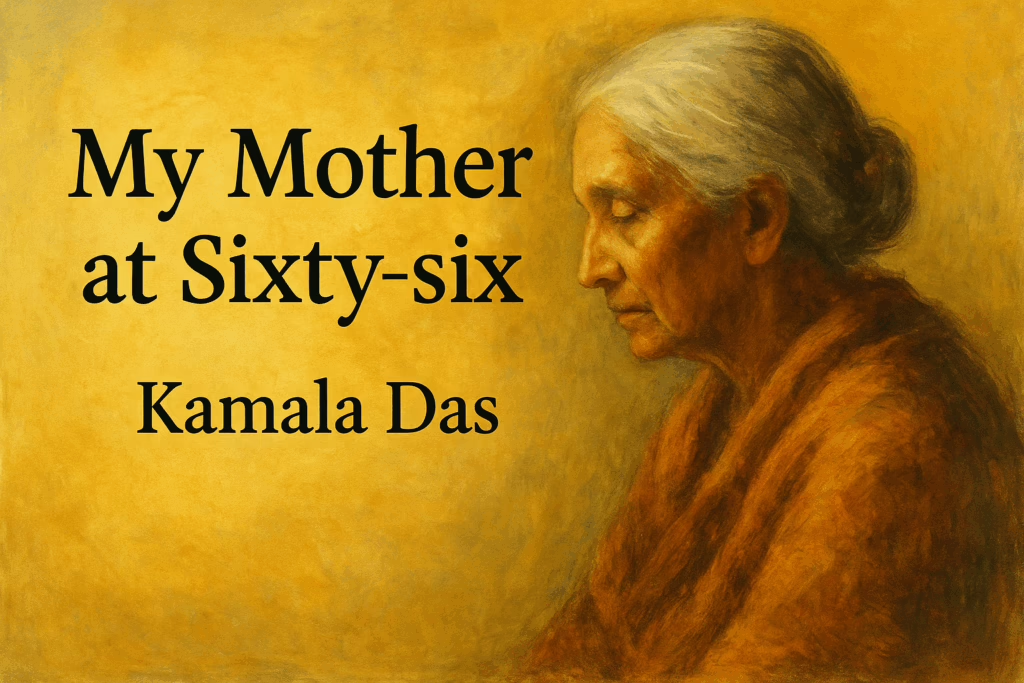Kamala Das’s My Mother at Sixty-six is a poem that resonates deeply with readers for its quiet intensity and emotional honesty. In just a few lines, the poet captures a moment that is both ordinary and profoundly universal—the realisation that a loved one is ageing, and that time cannot be held back. The poem’s themes of fear, separation, and silent resilience make it especially meaningful for students studying human emotions and poetic expression.
To help learners explore the poem more thoroughly, a wide range of exam-oriented questions becomes essential. These additional CBSE-style questions—ranging from short answers to extract-based and value-based ones—offer students an opportunity to analyse the poem from multiple angles. They encourage deeper reflection on the poet’s imagery, themes, emotional nuances, and stylistic choices, enabling a clearer understanding of how poetry transforms everyday experiences into lasting expressions of human feeling.
This article presents a comprehensive set of such questions and answers designed to strengthen conceptual clarity, improve exam readiness, and inspire a more sensitive reading of this heartfelt poem.

A. SHORT ANSWER QUESTIONS (2–3 marks each)
1. What contrast does the poet draw between her mother and the outside scene?
The poet’s mother appears old, pale, and lifeless, “ashen like a corpse,” symbolising decay. In contrast, the young trees “sprinting” and the children “spilling out of their homes” symbolise life, energy, and movement. This contrast highlights the poet’s emotional conflict as she confronts her mother’s ageing.
2. Why does the poet try to divert her mind by looking outside the car?
The sight of her mother’s lifeless, aged face fills the poet with pain and fear. To avoid confronting the harsh reality of her mother’s ageing, she looks at the lively images outside the car—trees and children—to distract herself emotionally.
3. What does the poet mean by “that old familiar ache”?
The phrase refers to the poet’s deep-rooted, childhood fear of losing her mother. The sight of her mother’s frailty revives this old fear, causing a painful emotional ache that the poet has carried for years.
4. Why does the poet smile again and again at the airport?
The repeated smile is an act of emotional courage. The poet tries to hide her fear and reassure her mother, even though she is deeply troubled by the thought of separation and ageing. The smile is a mask over her inner grief.
5. How is the mother described when the poet sees her at the airport?
The mother is described as “wan, pale as a late winter’s moon,” which suggests her weakness, fading energy, and the inevitable decline brought by old age.

B. LONG ANSWER QUESTIONS (5–6 marks each)
1. Discuss how the poem “My Mother at Sixty-six” explores the theme of ageing and the fear of separation.
The poem captures a daughter’s painful realisation of her mother’s ageing. The mother’s “ashen” and “corpse-like” appearance triggers the poet’s childhood fear of losing her. The contrasting images of vibrant life outside the car intensify the emotional conflict. At the airport, the mother appears even more fragile—“pale as a late winter’s moon.” The poet’s repeated smile reflects her attempt to hide her grief and be strong for her mother. Through simple yet powerful images, the poem beautifully expresses universal human emotions of love, ageing, and the fear of separation.
2. Analyse the use of imagery in the poem. How does it deepen the emotional impact?
The poem uses vivid imagery to portray emotional states. The mother’s “ashen,” “open-mouthed” face creates a striking image of ageing and mortality. The “sprinting” trees and “merry children” contrast sharply with this decay, symbolising vitality and youth. Later, the mother is compared to a “late winter’s moon,” an image that conveys fading strength and pale fragility. These images highlight the poet’s inner turmoil and enhance the emotional depth of the poem’s central theme—fear of losing a loved one.
3. The poem is written as a single sentence. Comment on its significance.
The poem’s single-sentence structure reflects the poet’s continuous stream of thoughts and emotions as she travels with her mother. The lack of full stops mirrors the flow of anxiety, observations, memories, and love—all racing through her mind. This uninterrupted form reinforces the intensity of the moment and the emotional rush the poet experiences.

C. EXTRACT-BASED QUESTIONS
Extract 1:
“…her face ashen like that of a corpse…”
Questions:
- Whose face is being described here?
- What does “ashen” suggest?
- How does this image affect the poet?
Answers:
- The poet’s mother’s face is being described.
- “Ashen” suggests paleness, lifelessness, and the weakening effects of old age.
- It causes the poet deep pain as she realises her mother’s approaching frailty and mortality.
Extract 2:
“I looked again at her, wan, pale as a late winter’s moon…”
Questions:
- When does the poet look at her mother again?
- Why is her mother compared to a late winter’s moon?
- What emotion does this evoke in the poet?
Answers:
- After the airport’s security check.
- The late winter’s moon is pale, faint, and weak—symbolic of the mother’s fragile state.
- It revives the poet’s old fear of losing her mother.
D. VALUE-BASED / OPINION QUESTIONS
1. What does the poem teach us about relationships with ageing parents?
The poem reminds us to cherish our ageing parents and acknowledge their emotional vulnerabilities. It teaches us to offer reassurance, love, and presence, even when internally we struggle with fears of separation.
2. How does the poet’s reaction reflect real human behaviour in painful situations?
Like many people, the poet hides her pain behind a smile, avoiding direct confrontation with harsh realities. This reflects the common human tendency to suppress difficult emotions in order to protect loved ones.



